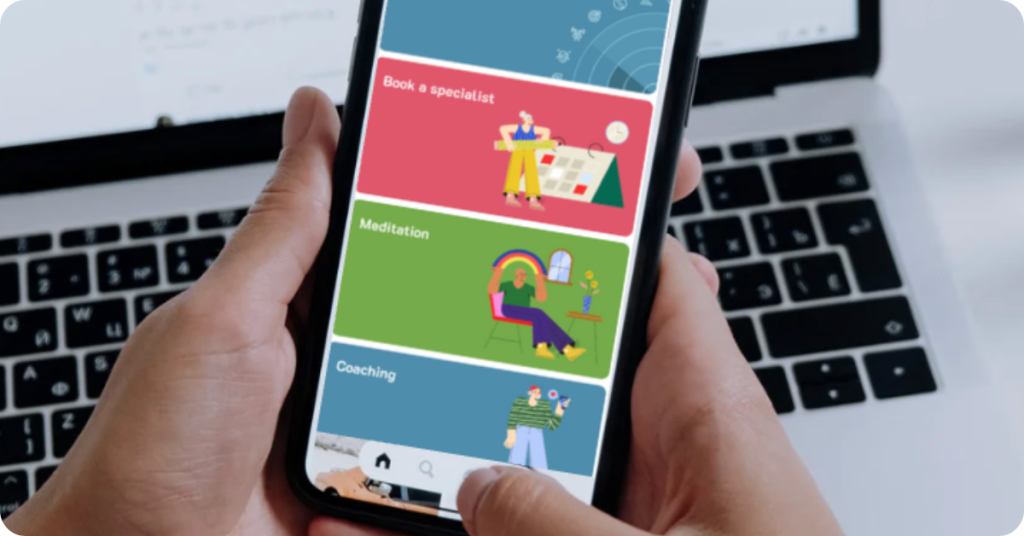The rise of virtual mental health support
-
 Morgane Oléron
Morgane Oléron

Virtual Mental Health Support, also known as teletherapy or online therapy, refers to any mental health service delivered remotely through digital platforms, rather than face-to-face in an office.
Trend & Innovations
The last years have seen a surge of virtual mental health services primarily due to mental health issues both rising and being more talked about, as well as the shift towards more hybrid and remote work solutions post-pandemic.
Indeed, since COVID, the world of work has seen an increase in mental health conditions such as anxiety, stress, depression, and burnout.
The increased demand for support is one of the main reasons for the expansion of digital mental health platforms.
In parallel, the global transition to remote work fundamentally changed how people access mental health support.
Finally, the use of smartphones also played a role in the rise of virtual mental health support, as it has now become the more common way to access the internet (rather than a computer).
Telling Data
In 2024, there were 6.3 billion smartphone users worldwide, and over 20,000 mental health apps were available for download.
The global virtual health service market is estimated to reach $19.45 billion in 2025 and is projected to grow to $137.99 billion by 2032. The global spending by consumers on mental health apps reached $491 million in 2022, representing an 82.5% increase since 2020.
In Europe, the digital mental health market is valued at $8.5 billion in 2025, projected to reach $23.8 billion by 2033.
In the US, 46% of adults aged 18-34 have used mental health apps at least once, and 60% of college students use mental health apps to manage well-being.
What are people looking for:
On the apps, individuals are primarily looking for support regarding:
- Stress and Anxiety Management
Guided meditation sessions, breathing exercises, and mindfulness practices are top features. - Sleep Improvement
Sleep tools, such as sleep stories, white noise, and bedtime routines, are highly sought after by users struggling with insomnia or disrupted sleep patterns. - Online Therapy and Counseling
Many users seek direct access to licensed therapists through text, audio, and video chat. - Mood and Symptom Tracking
Apps allowing users to log emotions, track moods, and receive customized insights on patterns and triggers promote self-awareness and early intervention. - Cognitive Behavioral Therapy (CBT) Tools
Self-guided CBT modules and exercises are popular for managing negative thought patterns, promoting resilience, and coping with anxiety, depression, and stress. - Healthy Habits and Positive Psychology
Users seek help in building positive habits, setting goals, and engaging in activities (such as gratitude journaling) that promote happiness and overall well-being.

Advantages of Virtual Mental Health Solutions for Tech Companies
Unique Challenges Faced by Tech Teams
We have seen in past pieces how working for a high-paced tech company can take a toll on individuals' mental health. Indeed, the tech industry is known for its high-pressure environment, rapid innovation cycles, and high propensity for distributed teams and remote workers, which can lead to potential isolation and a challenging work-life balance. A fast-paced environment for which traditional mental health services are not always ready to handle.
Advantages of virtual mental health
Digital platforms allow for early detection of mental health challenges and more proactive support, meeting the demand for scalable, accessible care through:
Convenience
- 24/7 access, asynchronous options, and mobile-friendly platforms
- Elimination of commuting and waiting times
Accessibility
- Broader access regardless of geographic location
- Support for diverse and international teams
- Availability of various languages and cultural contexts

Cost-Effectiveness
- Lower costs compared to in-person therapy
- Scalable plans for companies (subscription or pay-as-you-go models)
- Reduction in absenteeism and turnover rates through better screening and a proactive approach
Improved data accuracy
Smartphones allow for digital phenotyping. That is defined as the process of analyzing behavioral data from digital devices to understand a person's mental state and behavior. Indeed, smartphones not only provide access to the app but also collect a wealth of metrics about the individual (sleep, exercise, etc.). This is both great, but it could also lead to some privacy issues.
Potential Challenges and Considerations
While apps are proven to be increasingly helpful, there are, of course, some potential challenges to consider, such as data security and confidentiality, as well as potential frustration due to glitches or "one-size-fits-all" services, which do not take into consideration the full spectrum of mental health issues, ranging from mild stress to several mental illnesses.
Implementation Strategy for Tech Teams
It is essential nowadays for any company, and especially tech teams, to offer digital mental health support to their employees. However, one of the biggest challenges in using these tools remains engagement and adherence. Getting individuals to download the app and then actually use it has proven complicated for many apps. The company must implement the new service/tool with a strategy in mind, from launch to communication campaign, leadership buy-in, regular updates, feedback sessions, and reminders.
It is the leadership or HR department's role to ensure that the app they choose allows for personalization and seamless integration into daily life, is inclusive and trustworthy, and that employees can also reach out to human support.

Adopting digital mental health services is an obvious choice for most companies in today's world, especially tech businesses, as they need quick, tailored, and easy-to-use access to mental health support on the go at all times to not only prevent but also accompany individuals in their mental health and well-being journey. While there are still some considerations in terms of engagement and data safety, and the chosen third-party partner needs to be thoroughly researched, it makes sense for tech teams to invest in such support for the benefit of their employees and their productivity.
About the author

Morgane Oléron
Psychology Content Writer at Siffi
Morgane crafts compassionate, engaging content that makes mental health conversations more human and accessible. At Siffi, she combines storytelling with strategy to foster a culture of care and connection in the workplace.
Recent Posts
-
The 5 key habits of highly successful companies in employee mental wellbeing17 Nov 2025
-
Addressing survivor guilt after layoffs: how HR can support recovery10 Nov 2025
-
Breaking the silence: Supporting men's mental health in your workplace03 Nov 2025
-
Mental health informed performance management: A guide for HR27 Oct 2025
Sign up for our newsletter and get monthly tips and tricks for better mental well-being from our certified therapists and coaches.